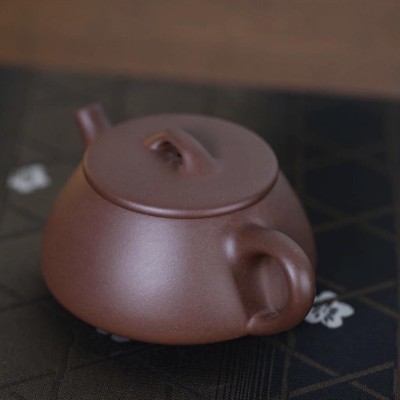








"Shipiao" Yixing teapot- this zisha teapot is a traditional Chinese tea set characterized by its gourd-like or calabash-like shape, with a small top and large bottom, a sturdy and short spout, and a pyramid-shaped body that exudes elegance. Made from high-quality purple clay material, this teapot is known for its hardness and durability, as well as its stable and easy-to-use design. The short and powerful straight spout ensures a smooth and steady flow of water, while the pyramid-shaped body adds a touch of sophistication to any tea ceremony.
 Delivery
Delivery
Free shipping within 1 to 3 days. ETA:5-7 days
 Returns
Returns
Within 28 days after delivery date.
 Security
Security
SSL | GDRP used to ensure information security.
Guarantee safe & secure checkout
Data sheet
I bought this yixing teapot for my husband and he absolutely loves it. The size is perfect for brewing a few cups of tea, and the quality is top-notch. The clay material gives it a unique charm, and the pour is smooth and precise. It's a beautiful addition to our tea set and has become a favorite for enjoying our daily tea rituals.
I recently purchased this yixing teapot and I have to say, the craftsmanship is stunning. The attention to detail is impeccable, and the elegant design adds a touch of sophistication to my tea time. The pour is smooth and the heat retention is exceptional. It's now a prized possession in my teaware collection.
"De" means morality,"zhong" means "bell",The bell-shaped lid and body of this zisha teapot symbolize a person with noble character, frugality, and simplicity. Owning this teapot is seen as a sign of being a true gentleman, as it represents the values of humility and refinement.
"De" means morality,"zhong" means "bell",The bell-shaped lid and body of this zisha teapot symbolize a person with noble character, frugality, and simplicity. Owning this teapot is seen as a sign of being a true gentleman, as it represents the values of humility and refinement.
"Handui", also known as the bell of the Han Dynasty, is a type of instrument.
"Shipiao" Yixing teapot- this zisha teapot is a traditional Chinese tea set characterized by its gourd-like or calabash-like shape, with a small top and large bottom, a sturdy and short spout, and a pyramid-shaped body that exudes elegance. Made from high-quality purple clay material, this teapot is known for its hardness and durability, as well as its stable and easy-to-use design. The short and powerful straight spout ensures a smooth and steady flow of water, while the pyramid-shaped body adds a touch of sophistication to any tea ceremony.
"Shipiao" Yixing teapot- this zisha teapot is a traditional Chinese tea set characterized by its gourd-like or calabash-like shape, with a small top and large bottom, a sturdy and short spout, and a pyramid-shaped body that exudes elegance. Made from high-quality purple clay material, this teapot is known for its hardness and durability, as well as its stable and easy-to-use design. The short and powerful straight spout ensures a smooth and steady flow of water, while the pyramid-shaped body adds a touch of sophistication to any tea ceremony.
"Xishi" yixing teapot is the quintessential model and the most popular style of Yixing clay teapot. It boasts a round and plump body, a cut lid, a short spout, and an inverted handle. The pot's body resembles the full breast of a young woman, while the knob on the lid is shaped like a nipple. The bottom of the pot curves inward naturally, and the handle is fashioned like an upside-down ear, reminiscent of the hairstyle of ancient Chinese women. When pouring tea, the handle resembles the slender waist of a beautiful woman. The Xishi teapot is renowned for its unique ability to brew tea, allowing the tea leaves to fully expand and release a more intense aroma and flavor.
"wendan" in Chinese refers to softness, appearance, and demeanor, while "dan" refers to the female roles in traditional Chinese opera. To literati, the charm and style of the "wendan" teapot are comparable to the beauty of a woman's shoulder, soft and boneless, like the alluring curves of "Xishi", exuding a natural grace and charm. The "wen" in "wendan" represents the soft, delicate appearance of the teapot, while the "dan" represents the feminine qualities that the teapot embodies. The "wendan" teapot is highly valued for its unique and elegant shape, which exudes a natural beauty and grace that is reminiscent of the beauty of a woman.
"Xiaoying" yixing zisha teapot - This zisha teapot embodies the Chinese values of peace, harmony, and pursuit of happiness. Its name "xiaoying" means "smiling and peaceful," reflecting an optimistic and open-minded attitude. Although the teapot itself does not have a smile, its pot body exudes a sense of joy and contentment, making the viewer feel its "smile" meaning.
"De" means morality,"zhong" means "bell",The bell-shaped lid and body of this zisha teapot symbolize a person with noble character, frugality, and simplicity. Owning this teapot is seen as a sign of being a true gentleman, as it represents the values of humility and refinement.
"Shipiao" Yixing teapot- this zisha teapot is a traditional Chinese tea set characterized by its gourd-like or calabash-like shape, with a small top and large bottom, a sturdy and short spout, and a pyramid-shaped body that exudes elegance. Made from high-quality purple clay material, this teapot is known for its hardness and durability, as well as its stable and easy-to-use design. The short and powerful straight spout ensures a smooth and steady flow of water, while the pyramid-shaped body adds a touch of sophistication to any tea ceremony.
"Shuiping“ zisha teapot-Chinese Kung Fu tea is a traditional brewing method that involves putting a large amount of tea leaves in a teapot and only brewing with boiling water, allowing the tea juice to slowly seep out. To achieve this, the teapot must be placed in a tea bowl or tea sea, with hot water poured around the outside of the teapot, causing it to float in the hot water and allowing the tea juice to be brewed. This requires an exquisite production process, with the clay used for the spout and handle of the teapot being of equal quality. When the teapot floats on the surface of the water, it must maintain a horizontal position without tilting, hence the name "shuiping" teapot.
The Melon-shaped Yixing teapot is a classic example of the zisha teapot. It is characterized by its unique shape, which resembles some melon , and is made of purple clay, also known as zisha clay.
"Fanggu" Yixing Teapot - This zisha teapot has an antique cylindrical body shaped like a drum, with a short neck imitating the shape of a drum pot. The spout is also designed to imitate the shape of a drum pot spout, with a straight line. Its advantages include excellent heat preservation, natural color, comfortable texture, and long service life. The "Fanggu" teapot is a unique and elegant choice for tea lovers and collectors alike.
"Rongtian" yixing teapot takes its inspiration from the "big-bellied" Arhat in Buddhism, named after the saying "a big belly can hold the world's affairs". It is difficult to fully capture the charm of this teapot, as it requires the maker to truly understand its essence. A slightly shorter neck is added to the full-bodied teapot, while the lid is raised to a half-spherical shape, giving it a simple and childlike charm. The teapot has excellent pouring performance and is comfortable to use. Visually, it exudes a dignified and generous aura while embodying depth within simplicity.
"De" means morality,"zhong" means "bell",The bell-shaped lid and body of this zisha teapot symbolize a person with noble character, frugality, and simplicity. Owning this teapot is seen as a sign of being a true gentleman, as it represents the values of humility and refinement.
"Julun" yixing teapot- this "Julun" zisha teapot is designed for practicality, with a spout that ensures smooth water flow and a handle that is easy to grip. The lid is also uniquely designed for easy removal. Despite its distinctive and eye-catching appearance, the "Julun" teapot is a functional and practical utensil that is highly valued by tea enthusiasts for its ability to brew tea effectively and efficiently. Its unique shape allows tea leaves to fully expand, releasing more aroma and flavor. The name "JuLun" comes from its shape, which resembles an upside-down cartwheel. This teapot is not only aesthetically pleasing but also highly functional, making it a popular choice among tea lovers and collectors.
NOTICE : Cookies ensure the smooth running of our services and improve user experience,Using these, you accept the use of cookies. Learn More.